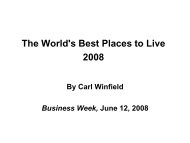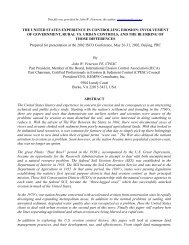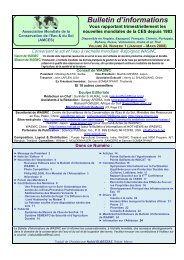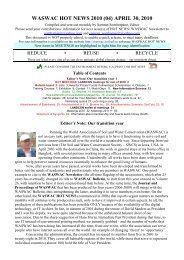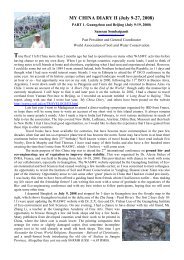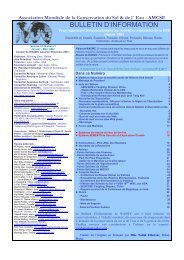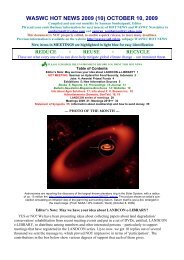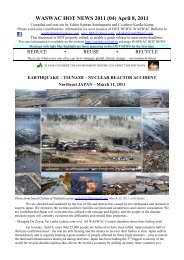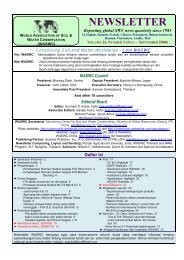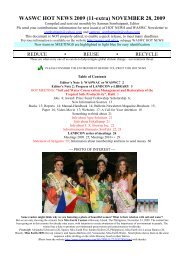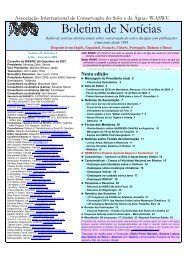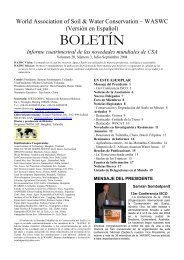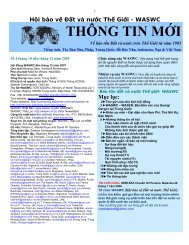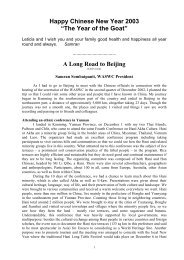Soils of the European Union - European Soil Portal - Europa
Soils of the European Union - European Soil Portal - Europa
Soils of the European Union - European Soil Portal - Europa
You also want an ePaper? Increase the reach of your titles
YUMPU automatically turns print PDFs into web optimized ePapers that Google loves.
3. base saturation (by 1 M NH 4 OAc) <strong>of</strong> less than 50 percent on a weighted average throughout <strong>the</strong> depth <strong>of</strong> <strong>the</strong>horizon; and4. organic carbon content <strong>of</strong> 0.6 percent (1 percent organic matter) or more throughout <strong>the</strong> thickness <strong>of</strong> mixedhorizon (usually it is more than 2 to 5 percent, depending on <strong>the</strong> clay content). The organic carbon content is atleast 0.6 percent more than <strong>the</strong> C horizon if <strong>the</strong> colour requirements are waived because <strong>of</strong> dark coloured parentmaterials; and5. <strong>the</strong> following thickness requirements:a. 10 cm or more if resting directly on hard rock, a petroplinthic or petroduric horizon, or overlying a cryichorizon; orb. at least 20 cm and more than one-third <strong>of</strong> <strong>the</strong> thickness <strong>of</strong> <strong>the</strong> solum where <strong>the</strong> solum is less than 75 cmthick; orc. more than 25 cm where <strong>the</strong> solum is more than 75 cm thick.The measurement <strong>of</strong> <strong>the</strong> thickness includes transitional AB, AE and AC horizons. The requirements for an umbrichorizon must be met after <strong>the</strong> first 20 cm are mixed, as in ploughing.Field identification. The main field characteristics used to identify <strong>the</strong> presence <strong>of</strong> an umbric horizon are its dark colour andits structure. In general, umbric horizons tend to have a lesser grade <strong>of</strong> soil structure than mollic horizons. As a guide, mostumbric horizons have an acid soil reaction (pH (H 2 O, 1:2.5) <strong>of</strong> less than about 5.5) which represents a base saturation <strong>of</strong>less than 50 percent. An additional indication for <strong>the</strong> acidity is a rooting pattern in which most <strong>of</strong> <strong>the</strong> roots tend to behorizontal, in <strong>the</strong> absence <strong>of</strong> a physical rootrestricting barrier.Relationships with some o<strong>the</strong>r diagnostic horizons. The base saturation requirement sets <strong>the</strong> umbric horizon apart from <strong>the</strong>mollic horizon, which o<strong>the</strong>rwise is very similar. The upper limit <strong>of</strong> organic carbon content varies from 12 percent (20percent organic matter) to 18 percent (30 percent organic matter) which is <strong>the</strong> lower limit for <strong>the</strong> histic horizon, or 20percent, <strong>the</strong> lower limit <strong>of</strong> a folic horizon. Limits with base-desaturated fulvic and melanic horizons are set by <strong>the</strong>combination <strong>of</strong> <strong>the</strong> intense dark colour, <strong>the</strong> high organic carbon content, <strong>the</strong> thickness and <strong>the</strong> characteristics associatedwith andic horizons in <strong>the</strong>se two horizons. O<strong>the</strong>rwise, umbric horizons frequently occur in association with andic horizons.Some thick, dark coloured, organic-rich, base-desaturated surface horizons occur which are formed as a result <strong>of</strong> humanactivities such as deep cultivation and manuring, <strong>the</strong> addition <strong>of</strong> organic manures, <strong>the</strong> presence <strong>of</strong> ancient settlements,kitchen middens, etc. (cf. anthropedogenic horizons). These horizons can usually be recognized in <strong>the</strong> field by <strong>the</strong> presence<strong>of</strong> artifacts, spade marks, contrasting mineral inclusions or stratification indicating <strong>the</strong> intermittent addition <strong>of</strong> manurialmaterial, a relative higher position in <strong>the</strong> landscape, or by checking <strong>the</strong> agricultural history <strong>of</strong> <strong>the</strong> area. If hortic or plaggichorizons are present, ei<strong>the</strong>r <strong>the</strong> 0.5 M NaHCO 3 P 2 O 5 analysis (Gong et al., 1997) or <strong>the</strong> 1 percent citric acid soluble P 2 O 5analysis may give an indication.Vertic horizonGeneral description. The vertic horizon (from L. vertere, to turn) is a clayey subsurface horizon which as a result <strong>of</strong>shrinking and swelling has polished and grooved ped surfaces ('slickensides'), or wedge-shaped or parallelepiped structuralaggregates.Diagnostic criteria. A vertic horizon must have:1. 30 percent or more clay throughout; and2. wedge-shaped or parallelepiped structural aggregates with a longitudinal axis tilted between 10° and 60° from <strong>the</strong>horizontal; and3. intersecting slickensides 7 ; and4. a thickness <strong>of</strong> 25 cm or more.Field identification. Vertic horizons are clayey, and have a hard to very hard consistency. When dry, vertic horizons showcracks <strong>of</strong> 1 or more centimetre wide. In <strong>the</strong> field <strong>the</strong> presence <strong>of</strong> polished, shiny ped surfaces ("slickensides") which <strong>of</strong>tenshow sharp angles with each o<strong>the</strong>r, is very obvious.7 Slickensides are polished and grooved ped surfaces which are produced by one soil mass sliding past ano<strong>the</strong>r.78



